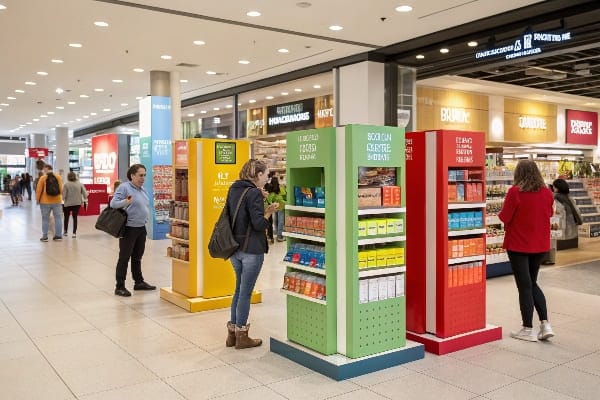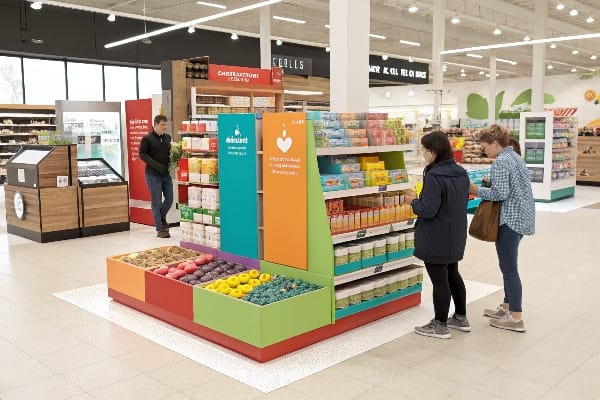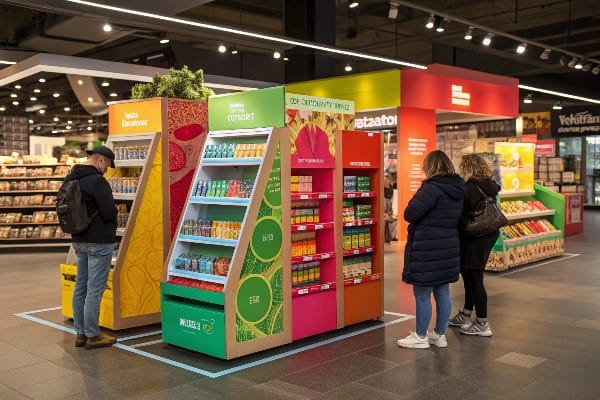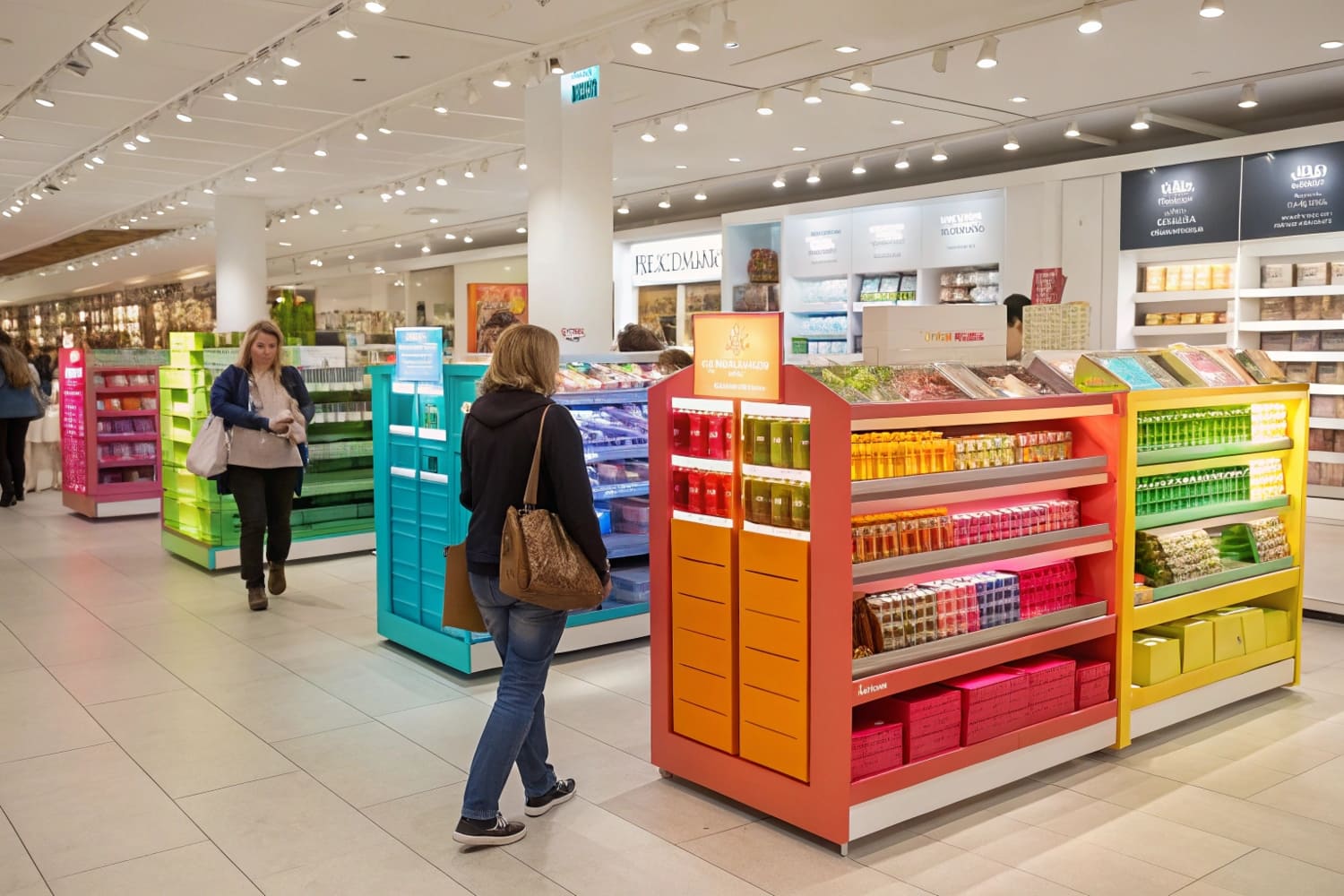Shoppers feel rushed. Shelves look the same. Good products get lost. I fix that with displays. I use simple structure, clear graphics, and strong paperboard to win attention fast.
Retail displays matter because they grab attention, guide choices, and convert interest into sales; they also carry brand stories, improve navigation, support launches, and add sustainable value when made from recyclable cardboard with fast, flexible digital printing.

I build cardboard displays every week. I see what works. I see what fails. I run a factory with three lines. I test strength. I ship on time. I use simple rules that any team can apply today.
What is the purpose of a display?
Crowded aisles hide good products. New items fight for space. Teams need a simple tool to stand out. A display solves this in the most direct way.
A display exists to attract attention, explain value fast, guide the shopper to the product, and remove friction at the moment of choice, so more people buy with less effort.

What a display must do
I use four verbs: stop, show, steer, sell. The unit must stop feet. It must show benefits in five seconds1. It must steer hands to the right SKU. It must sell the first unit today and the next unit tomorrow. I learned this on a beverage launch where a floor unit beat shelf tags by a wide margin with the same price and the same media. The only change was a clear header and simple copy2. That result taught my team to cut words and enlarge benefits. We repeat that rule on every new mockup.
Quick structure map
| Goal | Why it matters | Proof of success | Design cue |
|---|---|---|---|
| Stop | Interrupt autopilot | Dwell time rises3 | Bold header, high contrast |
| Show | Remove doubt | Fewer questions | 1–3 benefits, big icons |
| Steer | Reduce search | Faster pick | Clear facings, tidy trays |
| Sell | Close now | Units per store grow | Offer flag, price clarity |
| Sustain | Lower impact | Retail approval | Recyclable board4, water-based ink |
I also design for setup speed5. Flat-pack cuts freight and time. Strong single-wall corrugated handles weight when engineered right. Digital print gives fast turns for seasonal pushes. Many reports show floor displays6 hold the largest POP share in stores, and their growth stays strong because impact is obvious.
Why is displaying merchandise important?
Great products do not help if people do not see them. Shoppers make fast choices. Clear displays keep choices simple and safe.
Displaying merchandise is important because visibility drives trial, structure reduces confusion, and clear cues speed decisions; this lifts conversion, reduces returns, and supports brand trust at the exact point of purchase.

How visibility turns into sales
I sell B2B, wholesale only, so I track units per store per week. When we place a PDQ on a busy counter, impulse units7 move. When we build a pallet for a club chain, families load up. The product did not change. The scene did. Displays create a stage. The shopper feels permission to pick up and inspect. Colors stay consistent because we manage print profiles. Strength holds because we test with real loads and transport drops. This simple work keeps damage low and confidence high.
Merchandising checklist
| Driver | Shopper effect | Retail win8 | My action |
|---|---|---|---|
| Visibility | Finds item fast | Higher throughput | Tall header, clean hierarchy |
| Education | Understands value | Fewer staff calls | Icons, simple copy, QR to video |
| Navigation | Less search | Smoother aisle flow | Arrows, category color blocks |
| Trust | Fewer doubts | Lower return rates | Certifications, honest claims |
| Sustainability9 | Feels good to buy | Policy compliance | Recycled board, water-based ink |
I build for markets that differ. North America stays steady and mature. Europe asks for greener inks and coatings10. Asia-Pacific grows fast with urban retail and e-commerce push. Digital printing helps short runs and personalization. These facts shape my display plans and guide my material choices.
What is the power of in-store displays?
Media brings people to the door. Displays close the loop. They turn attention into a physical choice when the hand meets the shelf.
The power of in-store displays is their timing: they influence decisions at the last step, where clear cues, social proof, and easy reach convert browsing into buying with measurable lift.

Why timing beats noise
I once supported a hunting brand that launched a new bow. The team had strict deadlines. The shelf was crowded. We built a floor unit with strong stance, heavy-duty trays, and simple safety cues. We added a QR code11 that played a quiet demo. Store staff told us questions dropped. Sell-through rose during the first four weeks. The lesson was simple. Meet the shopper at the place of action. Use short claims. Use one hero image. Keep parts tough. Cardboard can do this with the right folds and coatings. It ships flat. It sets up fast. It recycles.
Forces at work
| Force | What happens in the aisle | Display move |
|---|---|---|
| Proximity12 | Nearness beats intention | Put the unit where hands reach |
| Salience | The eye picks contrast | Use clear colors and big type |
| Simplicity | Fewer choices feel safer | Limit SKUs per face |
| Scarcity13 | Limited runs spark action | Numbered tags or seasonal frames |
| Social proof | Others picked this | "Top seller" or review stars |
Many POP reports show floor displays14 control a large share, sometimes near half of the category. This happens because they own space, tell a story, and hold real stock. Smart units now add sensors or AR links15. These tools add insight without losing speed.
What is a point of display in retail?
Teams mix terms like POS and POP. Some people mean checkout. Some people mean floor units. This creates confusion. I keep a simple map.
A point of display is any branded structure placed in-store to present, promote, and dispense merchandise—floor, pallet, countertop, shelf tray, clip strip, endcap, or interactive stand—built to guide shoppers and drive immediate sales.

Types and uses
I work across many formats. Countertop displays16 push impulse near checkout. Pallet displays17 win in club stores because they move volume and set up fast. Floor units carry a strong message and often anchor launches. Shelf trays improve blocking and keep packs neat. Clip strips rescue small items near related goods. Interactive kiosks18 add a demo when touch helps. I choose the format that fits the job, the budget, and the timeline. I also plan around tariffs, freight, and store rules. In 2025, some import tariffs rose, so I leaned harder into light board, flat-pack, and regional printing to protect margins and speed.
Format quick guide
| Format | Best location | Best use case | Notes |
|---|---|---|---|
| Floor display19 | Aisle or endcap | New launch, story | Big header, strong base |
| Pallet | Club floor | Bulk value | Prepack, quick set |
| Countertop | Checkout | Impulse | Keep small, tidy |
| Shelf tray | Aisle shelf | Blocking, order | Fit planogram |
| Clip strip | Near adjacents | Add-on items | Lightweight packs |
| Interactive20 | Demo zone | Education | QR or screen, short loop |
I choose recyclable corrugated21 as the core. Single-wall works for most jobs when engineered with right flutes and locks. Water-based inks keep compliance strong in Europe. Digital print cuts lead time for U.S. and APAC pushes. My factory tests load and drop before any mass run.
Conclusion
Displays work because they make choice easy. They bring the brand close. They hold stock. They tell a clear story. They sell now and learn fast for next time.
Discover techniques to quickly convey product benefits, enhancing customer engagement and boosting sales. ↩
Learn how to craft impactful headers and concise copy that capture attention and drive conversions. ↩
Understanding dwell time can help improve user engagement and retention on your website. ↩
Exploring recyclable materials can enhance sustainability efforts and appeal to eco-conscious consumers. ↩
Understanding setup speed can enhance your packaging efficiency and reduce costs, making it a crucial aspect of design. ↩
Exploring the effectiveness of floor displays can provide insights into maximizing retail impact and sales. ↩
Understanding impulse units can help you optimize product placement and boost sales effectively. ↩
Exploring this link will provide insights into how retail wins can enhance your merchandising strategy. ↩
Understanding sustainability's role can help you align your merchandising with consumer values and boost sales. ↩
Explore this link to understand the benefits and innovations in eco-friendly printing materials. ↩
Explore how QR codes can enhance customer engagement and streamline information access in marketing strategies. ↩
Understanding proximity can enhance your retail strategy, making products more accessible and appealing to customers. ↩
Exploring scarcity can reveal powerful marketing tactics that drive urgency and increase sales. ↩
Explore this link to understand how floor displays can enhance customer engagement and boost sales in retail environments. ↩
Discover how AR links can transform shopping experiences by providing interactive and informative content to customers. ↩
Explore this link to understand how countertop displays can enhance impulse buying and boost sales at checkout. ↩
Explore this resource to understand how pallet displays can enhance product visibility and drive sales effectively. ↩
Discover how interactive kiosks can elevate customer experience and provide valuable demos that drive sales. ↩
Explore this link to understand how floor displays can enhance product visibility and drive sales. ↩
Discover how interactive displays can educate customers and create memorable shopping experiences. ↩
Exploring this link will provide insights into the environmental advantages and applications of recyclable corrugated materials. ↩




